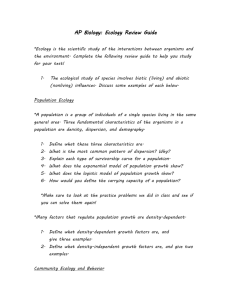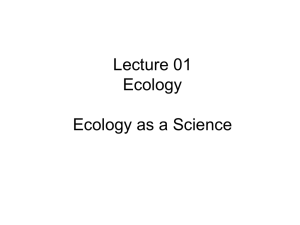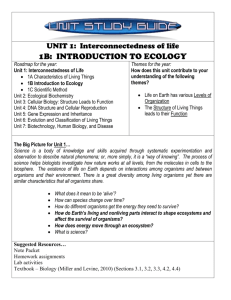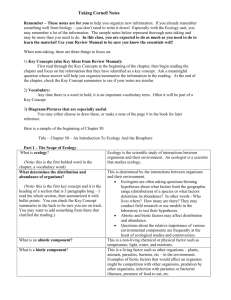Lecture 01 Ecology Ecology as a Science
advertisement
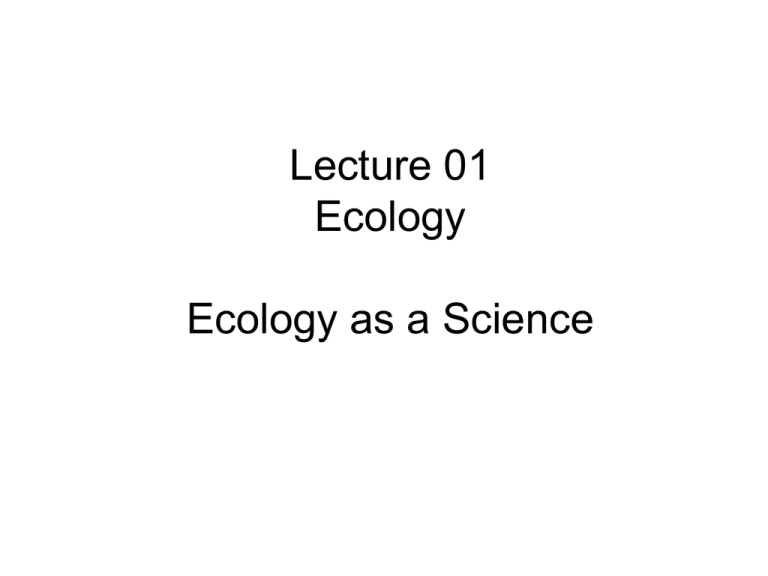
Lecture 01 Ecology Ecology as a Science • • • • • What is ecology? Characteristics of living things Levels of organization of living things Levels of organization of ecosystems Basic relationships within ecosystems – terminology • Scientific logic – how we know (what we think) we know • Ecology: – From Greek – oikos logos = knowledge of or study of one’s home – Study of distribution and abundance of living things and their interactions with each other and with their environment – Ecology as a Branch of Biology – study of living things What are the Characteristics of Living Things? All living organisms share five basic properties: 1. Cellular Organization – cell is basic unit of life 2. Metabolism – use energy 3. Homeostasis - maintain stable internal conditions 4. Growth and reproduction 5. Heredity living things come from living things Information for traits coded in DNA (deoxyribonucleic acid) Living things are organized as organisms: Atoms compounds cells tissues organs and organ systems organisms All living things composed of cells Not all organisms show all these levels of organization! Populations – single organisms – basic unit in ecology - fill a niche (‘job’ or function) communities - populations of many types of organisms ecosystems: All organisms living in an area, and the physical environment (habitat) with which these organisms interact. Organisms in an Ecosystem are Interrelated with Each Other and Their Environment • Every organism in an ecosystem has its niche • "When we try to pick out anything by itself, we find it hitched to everything in the universe.“ John Muir • Review of Ecological levels of organization • • • • • Individual/organism Population Community Ecosystems Bioshphere • The Organism • Functioning together with great precision, the organ systems make up the complex multicellular organism. Organisms interact to form still more complex levels of biological organization. • Populations • All the members of one species that live in the same area make up a population. • Community • The population of organisms that inhabit a particular area and interact with one another form a community. • Thus a community can be comprised of hundreds of different types of life forms. The study of how organisms of a community relate to one another and with their non-living environment is called "ecology". • Community • A community, together with its non-living environment is referred to as an "ecosystem". • Pond Tundra • Largest Ecosystem is the Biosphere Ecology vs. Environmentalism Environmentalist: • Save the world! – An emotion, a cause Ecologist: • Understand the world! – How does it work – uses scientific method – Poses specific questions in the form of hypothesis – Involves controlled experiments and detailed study Observation: Hydrangeas of the same variety but growing in different parts of the garden have different colors. Hypothesis: Something about the soil is different; perhaps acidity (pH). • Set up experiment to test hypothesis: – Grow one group of Hydrangeas in acid pH – Grow second group of hydrangeas in soil with basic pH – Keep everything else the same – Observe: Acid pH Alkaline pH Scientific Theory • Hypotheses are tentative explanations – phenomenon in a particular situation • Theories are widely accepted explanations – Support from many lines of evidence – Basis of understanding – May be revised or modified – Theory of Evolution Warbler Feeding Zones 20 Observation Studies in Ecology • Investigates questions concerning (for example) – Species distribution – What species are present – Populations, reproductive success – How species interact – Changes in species make-up of a habitat – Migratory patterns and routes • Answers may – lead to more questions – Management decisions … Organisms Require Resources • Energy flows through ecosystems – Trophic levels = ‘feeding’ levels – Some energy is lost during transfer to each higher trophic level • Materials cycle – Carbon, phosphorus, nitrogen, water cycle through biotic and abiotic aspects of ecosystems – Global in scale Biotic cycling Biotic and Abiotic Nutrients Cycle • Include things like carbon, nitrogen, phosphorus – Some required in greater concentrations than others – Excesses may be toxic Copyright © The McGraw-Hill Companies, Inc. Permission required for reproduction or display. Top carnivores Carnivores Birds of prey Herbivores Photosynthesizers Decomposers Humans Birds Mammals Mammals Birds Inorganic nutrients Arthropods Fish Meiofauna Inorganic nutrients Bacteria and fungi Algae Inorganic nutrients Mollusks Annelids • • • • Summary Ecology is an investigative science that relies on the scientific method The scientific method requires observation, creation of a hypothesis, and data collection to refute or support the hypothesis. Ecology and evolution are two separate disciplines that overlap in their investigation of the natural world. An understanding of ecology may lead us to sound environmental decisions
